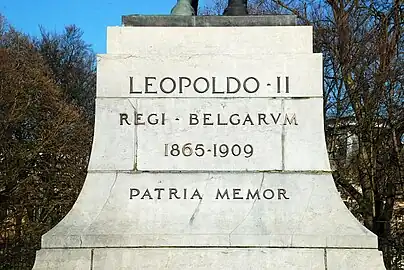Equestrian Statue of Leopold II, Brussels
The Equestrian Statue of Leopold II (French: Statue équestre de Léopold II, Dutch: Ruiterstandbeeld van Leopold II) is a bronze equestrian statue erected in Brussels, Belgium, in memory of King Leopold II, second King of the Belgians. It was created by the sculptor Thomas Vinçotte in 1914,[1] but it was not finalised until 1926 by the architect François Malfait, when it was inaugurated in honour of the king.[2]
 Statue of King Leopold II | |
| 50°50′26″N 4°21′52″E | |
| Location | Place du Trône / Troonplein B-1000 City of Brussels, Brussels-Capital Region, Belgium |
|---|---|
| Designer | Thomas Vinçotte, François Malfait |
| Type | Equestrian statue |
| Completion date | 1926 |
| Dedicated to | King Leopold II |
The statue stands on the Place du Trône/Troonplein, to the south-east of the Royal Palace of Brussels, at the point where the Rue Ducale/Hertogsstraat joins the Boulevard du Régent/Regentlaan (Small Ring), and a few tens of metres from the Royal Stables of Brussels. It is also close to Matongé, an African (mainly Congolese) district of Ixelles. This area is served by Brussels Central Station, as well as by the metro stations Parc/Park (on lines 1 and 5) and Trône/Troon (on lines 2 and 6).
History

King Leopold II died in 1909, and as for many Kings of the Belgians, the Belgian authorities took the initiative, in 1914, to erect a statue in his honour.[3] To do this, the Belgian State collected more than 625,000 Belgian francs.[lower-alpha 1] On 31 May 1914, the Belgian official journal and the press launched an appeal for anyone who wanted to contribute to erecting the statue. The initiative was successful, in which even Leopold's successor, King Albert I, himself took part and responded to the appeal along with some citizens.[4]
The statue's construction, however, was delayed due to the First World War and it is necessary to wait until the end of the war for the work to be redesigned by the sculptor Thomas Vinçotte with the help of the architect François Malfait and the Union Minière du Haut-Katanga which, for its part, provided the raw material. The bronze statue was cast by the Compagnie des Bronzes de Bruxelles and was inaugurated on 15 November 1926, the feast day of the dynasty, but also the patronal feast of Leopold II.[5] This ceremony was marked by the presence of the entire Belgian royal family and the authorities who came in procession to the scene.[6]
Controversies
Since the 21st century, the statue has aroused many controversies as to its presence in the centre of Brussels since the figure of Leopold II is no longer as admired and respected as at the time of its construction. Indeed, it is today mainly associated with Belgian colonial history and the Congo Free State, a territory over which Leopold exercised de facto sovereignty from 1885 to 1908.[7][8]
The statue has been vandalised several times with red and white paint, including by the writer and activist Théophile de Giraud in 2008.[9][10] In June 2020, a petition for its removal was signed over 45,000 times within several days.[11] A majority in the Brussels Parliament wants to either recontextualise or remove all Leopold II statues in Brussels, including this one.[12]
 Equestrian statue
Equestrian statue Closeup of King Leopold II
Closeup of King Leopold II
See also
References
Footnotes
- This amount is roughly equivalent to €2.5 million in 2020 when taking into account inflation.
Notes
- Loze, Vautier & Vestre 1990, p. 275.
- Mardaga 1994, p. 412.
- X, Léopold II. Les monuments de Bruxelles et de Léopoldville (in French), Brussels, Vromant & Co, s.d., p. 5.
- X, Léopold II. Les monuments..., op.cit., p. 5.
- X, Léopold II. Les monuments..., op.cit., p. 10.
- X, Léopold II. Les monuments..., op.cit., p. 29.
- Pakenham, Thomas (1992). The Scramble for Africa: the White Man's Conquest of the Dark Continent from 1876 to 1912 (13th ed.). London: Abacus. pp. 253–5. ISBN 978-0-349-10449-2.
- Vanthemsche, G. (2012). Belgium and the Congo, 1885-1980. New York: Cambridge University Press. p. 41. ISBN 978-0-521-19421-1.
- "Congo: Histoire blanche, voix noires, zones grises" (PDF). Télé-Moustique (in French). 12 November 2008. Retrieved 1 March 2020.
- Siebe Jonckheere (22 November 2019). "De schuld in de onschuld van een straatnaam". Krant van West-Vlaanderen (in Dutch). Retrieved 7 June 2020.
- "Steeds meer protest in België tegen standbeelden Leopold II". NOS (in Dutch). 5 June 2020. Retrieved 7 June 2020.
- "Brusselse meerderheid vraagt dekolonisering van openbare ruimte". Bruzz (in Dutch). 4 June 2020. Retrieved 7 June 2020.
Bibliography
- Loze, Pierre; Vautier, Dominique; Vestre, Marina (1990). Guide de Bruxelles XIXème et Art Nouveau (in French). Brussels: Eiffel Editions - CFC Éditions.
- Le Patrimoine monumental de la Belgique: Bruxelles (PDF) (in French). Vol. 1C: Pentagone N-Z. Liège: Pierre Mardaga. 1994.